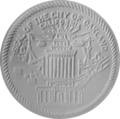Oakland Athletics
| Oakland Athletics | |||||
|---|---|---|---|---|---|
|
| |||||
| Established in 1901 | |||||
| Based in Oakland since 1968 | |||||
| |||||
| Major league affiliations | |||||
| |||||
| Current uniform | |||||
 | |||||
| Retired numbers | |||||
| Colors | |||||
| |||||
| Name | |||||
| Other nicknames | |||||
| |||||
| Ballpark | |||||
| Major league titles | |||||
| World Series titles (9) | |||||
| AL Pennants (15) | |||||
| West Division titles (16) | |||||
| Wild card berths (2) | |||||
| Front office | |||||
| Owner(s) | John J. Fisher | ||||
| Manager | Bob Melvin | ||||
| General Manager | David Forst | ||||
| President of Baseball Operations | Dave Kaval | ||||
The Oakland Athletics (often abbreviated to A's) are an American professional baseball team based in Oakland, California. The Athletics compete in Major League Baseball (MLB) as a member club of the American League (AL) West division. The club plays its home games at the Oakland–Alameda County Coliseum. The club has won nine World Series championships, the third most of all current Major League Baseball teams. The 2017 season will be the team's fiftieth in Oakland.
One of the American League's eight charter franchises, the club was founded in Philadelphia, in 1901 as the Philadelphia Athletics. They won three World Series championships from 1910 to 1913 and two in a row in 1929 and 1930. The team's owner and manager for its first 50 years was Connie Mack and Hall of Fame players included Chief Bender, Frank "Home Run" Baker, Jimmie Foxx, and Lefty Grove. The team left Philadelphia for Kansas City in 1955 and became the Kansas City Athletics before moving to Oakland in 1968. They won three World Championships in a row from 1972 to 1974, led by players including Catfish Hunter, Reggie Jackson, ace reliever Rollie Fingers, and colorful owner Charlie O. Finley. After being sold by Finley to Walter A. Haas Jr., the team won three consecutive pennants and the 1989 World Series behind the "Bash Brothers", Jose Canseco and Mark McGwire, as well as Hall of Famers Dennis Eckersley, Rickey Henderson and manager Tony La Russa.
The book Moneyball and its film adaptation show how the A's used evidence-based sabermetrics to compete despite their financial limitations around the turn of the millennium.
History
The history of the Athletics Major League Baseball franchise spans the period from 1901 to the present day, having begun in Philadelphia before moving to Kansas City in 1955 and then to its current home in Oakland, California, in 1968. The A's made their Bay Area debut on Wednesday, April 17, 1968, with a 4-1 loss to the Baltimore Orioles at the Coliseum, in front of an opening-night crowd of 50,164.[1]
Team name
The Athletics' name originated in the term "Athletic Club" for local gentlemen's clubs—dates to 1860 when an amateur team, the Athletic (Club) of Philadelphia, was formed. (A famous image from that era, published in Harper's Weekly in 1866, shows the Athletic players dressed in uniforms displaying the familiar blackletter "A" on the front.) The team later turned professional through 1875, becoming a charter member of the National League in 1876, but were expelled from the N.L. after one season. A later version of the Athletics played in the American Association from 1882–1891.
Elephant mascot
After New York Giants manager John McGraw told reporters that Philadelphia manufacturer Benjamin Shibe, who owned the controlling interest in the new team, had a "white elephant on his hands", team manager Connie Mack defiantly adopted the white elephant as the team mascot, and presented McGraw with a stuffed toy elephant at the start of the 1905 World Series.[2] McGraw and Mack had known each other for years, and McGraw accepted it graciously. By 1909, the A's were wearing an elephant logo on their sweaters, and in 1918 it turned up on the regular uniform jersey for the first time. Over the years the elephant has appeared in several different colors. It is currently white.
In 1963, when the A's were located in Kansas City, then owner Charlie Finley changed the team mascot from an elephant to a Missouri mule. This is rumored to have been done by Finley in order to appeal to fans from the region who were predominantly Democrats at the time. (The traditional Republican Party symbol is an elephant, while the Democratic Party's symbol is a donkey.) Since 1988, the Athletics' 21st season in Oakland, an illustration of an elephant has adorned the left sleeve of the A's home and road uniforms. Beginning in the mid 1980s, the on-field costumed incarnation of the A's elephant mascot went by the name Harry Elephante.[3] In 1997, he took his current form, Stomper.[4]
Team uniform
Through the seasons, the Athletics' uniforms have usually paid homage to their amateur forebears to some extent. Until 1954, when the uniforms had "Athletics" spelled out in script across the front, the team's name never appeared on either home or road uniforms. Furthermore, neither "Philadelphia" nor the letter "P" ever appeared on the uniform or cap. The typical Philadelphia uniform had only a script "A" on the left front, and likewise the cap usually had the same "A" on it. In the early days of the American League, the standings listed the club as "Athletic" rather than "Philadelphia", in keeping with the old tradition. Eventually, the city name came to be used for the team, as with the other major league clubs.
After buying the team in 1960, owner Charles O. Finley introduced new road uniforms with "Kansas City" printed on them, as well as an interlocking "KC" on the cap. Upon moving to Oakland, the "A" cap emblem was restored, although in 1970 an "apostrophe-s" was added to the cap and uniform emblem to reflect the fact that Finley was in the process of officially changing the team's name to the "A's."
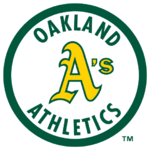
Also while in Kansas City, Finley changed the team's colors from their traditional red, white and blue to what he termed "Kelly Green, Wedding Gown White and Fort Knox Gold." It was also here that he began experimenting with dramatic uniforms to match these bright colors, such as gold sleeveless tops with green undershirts and gold pants. The innovative uniforms only increased after the team's move to Oakland, which also came at the time of the introduction of polyester pullover uniforms. During their dynasty years in the 1970s, the A's had dozens of uniform combinations with jerseys and pants in all three team colors, and in fact did not wear the traditional gray on the road, instead wearing green or gold, which helped to contribute to their nickname of "The Swingin' A's." After the team's sale to the Haas family, the team changed its primary color to a more subdued forest green and began a move back to more traditional uniforms.
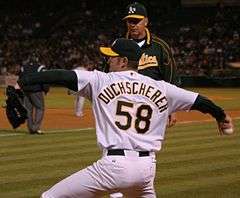
Currently, the team wears home uniforms with "Athletics" spelled out in script writing and road uniforms with "Oakland" spelled out in script writing, with the cap logo consisting of the traditional "A" with "apostrophe-s." The home cap is green with a gold bill and white lettering, while the road cap, debuting in 2014, is all green with "A's" in white with gold trim. Regardless of road or home games, the batting helmets used are green with gold brim. However, before 2009, when the black A's helmets appeared, road helmets were green with green brim.
From 1994 until 2013, the A's wore green alternate jerseys with the word "Athletics" in gold. It was used on both road and home games. During the 2000s, the Athletics introduced black as one of their colors. They began wearing a black alternate jersey with "Athletics" written in green. After a brief discontinuance, the A's brought back the black jersey, this time with "Athletics" written in white with gold highlights. Commercially popular but rarely chosen as the alternate by players, in 2011 they were replaced by a new gold alternate jersey with "A's" in green on the left chest. With the exception of several road games during the 2011 season, the Athletics' gold uniforms are used as the designated home alternates. A green version of their gold alternates was introduced for the 2014 season to replace their previous green alternates. The new green alternates feature the piping, "A's" and lettering in white with gold trim.
The nickname "A's" has long been used interchangeably with "Athletics", dating to the team's early days when headline writers wanted a way to shorten the name. From 1972 through 1980, the team nickname was officially "Oakland A's", although, during that time, the Commissioner's Trophy, given out annually to the winner of baseball's World Series, still listed the team's name as the "Oakland Athletics" on the gold-plated pennant representing the Oakland franchise. According to Bill Libby's Book, Charlie O and the Angry A's, owner Charlie O. Finley banned the word "Athletics" from the club's name because he felt that name was too closely associated with former Philadelphia Athletics owner Connie Mack, and he wanted the name "Oakland A's" to become just as closely associated with him. The name also vaguely suggested the name of the old minor league Oakland Oaks, which were alternatively called the "Acorns." New owner Walter Haas restored the official name to "Athletics" in 1981, but retained the nickname "A's" for marketing purposes. At first, the word "Athletics" was restored only to the club's logo, underneath the much larger stylized-"A" that had come to represent the team since the early days. By 1987, however, the word returned, in script lettering, to the front of the team's jerseys.
The A's are the only MLB team to wear white cleats, both at home and on the road, another tradition dating back to the Finley ownership.
Stadium
The Oakland Alameda Coliseum—originally known as the Oakland–Alameda County Coliseum, and later named as Network Associates, McAfee and Overstock.com Coliseum—was built as a multi-purpose facility. Louisiana Superdome officials pursued negotiations with Athletics officials during the 1978–79 baseball offseason about moving the Athletics to the Superdome in New Orleans. The Athletics were unable to break their lease at the Coliseum, and remained in Oakland.[5]
After the Oakland Raiders football team moved to Los Angeles in 1982, many improvements were made to what was suddenly a baseball-only facility. The 1994 movie Angels in the Outfield was filmed in part at the Coliseum, filling in for Anaheim Stadium.
Then, in 1995, a deal was struck whereby the Raiders would move back to Oakland for the 1995 season. The agreement called for the expansion of the Coliseum to 63,026 seats. The bucolic view of the Oakland foothills that baseball spectators enjoyed was replaced with a jarring view of an outfield grandstand contemptuously referred to as "Mount Davis" after Raiders' owner Al Davis. Because construction was not finished by the start of the 1996 season, the Athletics were forced to play their first six-game homestand at 9,300-seat Cashman Field in Las Vegas.[6]
Although official capacity was stated to be 43,662 for baseball, seats were sometimes sold in Mount Davis as well, pushing "real" capacity to the area of 60,000. The ready availability of tickets on game day made season tickets a tough sell, while crowds as high as 30,000 often seemed sparse in such a venue. On December 21, 2005, the Athletics announced that seats in the Coliseum's third deck would not be sold for the 2006 season, but would instead be covered with a tarp, and that tickets would no longer be sold in Mount Davis under any circumstances. That effectively reduced capacity to 34,077, making the Coliseum the smallest stadium in Major League Baseball. As of 2008, sections 316–318 are the only open third-deck sections for A's games, bringing the total capacity to 35,067. The Athletics are the only remaining MLB team still sharing a stadium with an NFL team on a full-time basis.
The Athletics' Spring training facility is Hohokam Stadium, located in Mesa, Arizona. From 1982 to 2014, their spring training facility was Phoenix Municipal Stadium, located in Phoenix, Arizona.[7] Previous spring-training sites since they moved to Oakland in 1968 were Yuma and Mesa, Arizona, as well as Las Vegas, Nevada, all in the 1970s.
New stadium proposals
Since the mid-2000s the A's have been in talks with Oakland and other Northern California cities about building a new baseball-only stadium. One planned stadium, Cisco Field, was originally intended to be built in Fremont, California (a location that has since been abandoned). As it stands, there are no talks of moving the team to San Jose after the U.S. Supreme Court blocked the Athletics move.[8]
Staying in Oakland
The most recent stadium happenings is a proposal to move out of the Coliseum and build a new A's stadium on the waterfront at the Port of Oakland. The proposed site is located at Howard Terminal at the Port of Oakland by the Jack London Square District. The Howard Terminal site is just one of five listed in a 21-page report that features at least 4 other sites in Oakland.[9]
Fremont
After the city of Oakland failed to make any progress toward a stadium, the A's began contemplating a move to the Warm Springs district of suburban Fremont. Fremont is about 25 miles south of Oakland; many nearby residents are already a part of the current Athletics fanbase.
On November 7, 2006, many media sources announced the Athletics would be leaving Oakland as early as 2010 for a new stadium in Fremont, confirmed the next day by the Fremont City Council. The plan was strongly supported by Fremont Mayor Bob Wasserman.[10] The team would have played in what was planned to be called Cisco Field, a 32,000-seat, baseball-only facility.[11] The proposed ballpark would have been part of a larger "ballpark village" which would have included retail and residential development. On February 24, 2009, however, Lew Wolff released an open letter regarding the end of his efforts to relocate the A's to Fremont, citing "real and threatened" delays to the project.[12] The project faced opposition from some in the community who thought the relocation of the A's to Fremont would increase traffic problems in the city and decrease property values near the ballpark site.
San Jose
In 2009, the City of San Jose attempted open negotiations with the team regarding a move to the city. Although parcels of land south of Diridon Station would be acquired by the city as a stadium site, the San Francisco Giants' claim on Santa Clara County as part of their home territory would have to be settled before any agreement could be made.[13]
By 2010, San Jose was "aggressively wooing" A's owner Lew Wolff. Wolff referred to San Jose as the team's "best option", but Major League Baseball Commissioner Bud Selig said he would wait on a report on whether the team could move to the area because of the Giants conflict.[14] In September 2010, 75 Silicon Valley CEOs drafted and signed a letter to Bud Selig urging a timely approval of the move to San Jose.[15] In May 2011, San Jose Mayor Chuck Reed sent a letter to Bud Selig asking the commissioner for a timetable of when he might decide whether the A's can pursue this new ballpark, but Selig did not respond.[16]
Selig addressed the San Jose issue via an online town hall forum held in July 2011, saying, "Well, the latest is, I have a small committee who has really assessed that whole situation, Oakland, San Francisco, and it is complex. You talk about complex situations; they have done a terrific job. I know there are some people who think it's taken too long and I understand that. I'm willing to accept that. But you make decisions like this; I've always said, you'd better be careful. Better to get it done right than to get it done fast. But we'll make a decision that's based on logic and reason at the proper time."[17]
On June 18, 2013, the City of San Jose filed suit against Selig, seeking the court's ruling that Major League Baseball may not prevent the Oakland A's from moving to San Jose.[18] Wolff criticized the lawsuit, stating he did not believe business disputes should be settled through legal action.[19]
Most of the city's claims were dismissed in October 2013, but a U.S. District Judge ruled that San Jose could move forward with its count that MLB illegally interfered with an option agreement between the city and the A's for land. On January 15, 2015, a three-judge panel of the 9th U.S. Circuit Court of Appeals ruled unanimously that the claims were barred by baseball's antitrust exemption, established by the U.S. Supreme Court in 1922 and upheld in 1953 and 1972. San Jose Mayor Sam Liccardo commented that the city would seek a ruling from the U.S. Supreme Court.[20] On October 5, 2015 the United States Supreme Court rejected San Jose's bid on the Athletics.[21]
Rivals
San Francisco Giants
The Bay Bridge Series is the name of a series games played between (and the rivalry of) the A's and San Francisco Giants of the National League. The series takes its name from the San Francisco–Oakland Bay Bridge which links the cities of Oakland and San Francisco. Although competitive, the regional rivalry between the A's and Giants is considered a friendly one with mostly mutual companionship between the fans, as opposed to White Sox–Cubs, or Yankees–Mets games where animosity runs high. Hats displaying both teams on the cap are sold from vendors at the games, and once in a while the teams both dress in uniforms from a historic era of their franchises.
The series is also occasionally referred to as the "BART Series" for the Bay Area Rapid Transit system that links Oakland to San Francisco. However, the name "BART Series" has never been popular beyond a small selection of history books and national broadcasters and has fallen out of favor. Bay Area locals almost exclusively refer to the rivalry as the "Battle of the Bay".
Originally, the term described a series of exhibition games played between the two clubs after the conclusion of spring training, immediately prior to the start of the regular season. It was first used to refer to the 1989 World Series in which the Athletics won their most recent championship and the first time both teams had met since they moved to the San Francisco Bay Area. Today, it also refers to games played between the teams during the regular season since the commencement of interleague play in 1997. Through the 2017 regular season, the A's have won 59 games, and the Giants have won 55 contests: The A's have held the head-to-head edge in this inter-league matchup for the past 12 years.[22]
The A's also have edges on the Giants in terms of overall postseason appearances (18-11), division titles (16-8) and World Series titles (4-3) since both teams moved to the Bay Area, even though the Giants franchise moved there a decade earlier than the A's did.
Historic rivalries
Philadelphia Phillies
The City Series was the name of a series of baseball games played between the Athletics and the Philadelphia Phillies of the National League that ran from 1903 through 1955. After the A's move to Kansas City in 1955, the City Series rivalry came to an end. The teams have since faced each other in interleague play (since its introduction in 1997) but the rivalry has effectively died in the intervening years since the A's left Philadelphia. In 2014, when the A's faced the Phillies in inter-league play at the Oakland Coliseum, the Athletics didn't bother to mark the historical connection, going so far as to have a Connie Mack promotion the day before the series while the Texas Rangers were in Oakland.[23]
The first City Series was held in 1883 between the Phillies and the American Association Philadelphia Athletics.[24] When the Athletics first joined the American League, the two teams played each other in a spring and fall series. No City Series was held in 1901 and 1902 due to legal warring between the National League and American League.
Achievements
Awards
- Catfish Hunter Award (2004–present)
Hall of Famers
| Oakland Athletics Hall of Famers | |||||||||||||||||||||||||||
|---|---|---|---|---|---|---|---|---|---|---|---|---|---|---|---|---|---|---|---|---|---|---|---|---|---|---|---|
| Affiliation according to the National Baseball Hall of Fame and Museum | |||||||||||||||||||||||||||
|
Ford C. Frick Award recipients
| Oakland Athletics Ford C. Frick Award recipients | |||||||||
|---|---|---|---|---|---|---|---|---|---|
| Affiliation according to the National Baseball Hall of Fame and Museum | |||||||||
|
Retired numbers
The Athletics have retired six numbers, and honored one additional individual with the letter "A". Walter A. Haas, Jr., owner of the team from 1980 until his death in 1995, was honored by the retirement of the letter "A". Of the six players with retired numbers, five were retired for their play with the Athletics and one, 42, was universally retired by Major League Baseball when they honored the 50th anniversary of Jackie Robinson's breaking the color barrier. No A's player from the Philadelphia era has his number retired by the organization. Though Jackson and Hunter played small portions of their careers in Kansas City, no player that played the majority of his years in the Kansas City era has his number retired either. The A's have retired only the numbers of Hall of Fame members who played large portions of their careers in Oakland. The Athletics have all of the numbers of the Hall-of-Fame players from the Philadelphia Athletics displayed at their stadium, as well as all of the years that the Philadelphia Athletics won World Championships (1910, 1911, 1913, 1929, and 1930.)
|
Bay Area Sports Hall of Fame
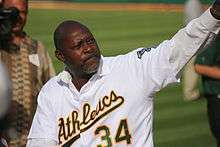
17 members of the Athletics organization have been honored with induction into the Bay Area Sports Hall of Fame.
| A's in the Bay Area Sports Hall of Fame | ||||
| No. | Player | Position | Tenure | Notes |
|---|---|---|---|---|
| 12 | Dusty Baker | OF | 1985–1986 | |
| 35 | Vida Blue | P | 1969–1977 | |
| 19 | Bert "Campy" Campaneris | SS | 1968–1976 | |
| 12 | Orlando Cepeda | 1B | 1972 | Elected mainly on his performance with San Francisco Giants |
| 14 | Sam Chapman | CF | 1938–1941 1945–1951 | Born and raised in Tiburon, California |
| 43 | Dennis Eckersley | P | 1987–1995 | Grew up in Fremont |
| 34 | Rollie Fingers | P | 1968–1976 | |
| — | Walter A. Haas, Jr. | Owner | 1981–1995 | Grew up in San Francisco, attended UC Berkeley |
| 27 | Catfish Hunter | P | 1968–1974 | |
| 9 | Reggie Jackson | RF | 1968–1975 1987 | |
| 1 | Eddie Joost | SS Manager | 1947–1954 1954 | Born and raised in San Francisco |
| 10 | Tony La Russa | IF Manager | 1963 1968–1971 1986–1995 | |
| 1 | Billy Martin | Manager | 1980–1982 | Elected mainly on his performance with New York Yankees, Born in Berkeley |
| 44 | Willie McCovey | 1B | 1976 | Elected mainly on his performance with San Francisco Giants |
| 8 | Joe Morgan | 2B | 1984 | Elected mainly on his performance with Cincinnati Reds, raised in Oakland |
| 19 | Dave Righetti | P | 1994 | Born and raised in San Jose |
| 34 | Dave Stewart | P | 1986–1992 1995 | Born and raised in Oakland |
Philadelphia Baseball Wall of Fame
The Athletics have all of the numbers of the Hall-of-Fame players from the Philadelphia Athletics displayed at their stadium, as well as all of the years that the Philadelphia Athletics won World Championships (1910, 1911, 1913, 1929, and 1930.)
Also, from 1978 to 2003 (except 1983), the Philadelphia Phillies inducted one former Athletic (and one former Phillie) each year into the Philadelphia Baseball Wall of Fame at the then-existing Veterans Stadium. 25 Athletics have been honored. In March 2004, after Veterans Stadium was replaced by the new Citizens Bank Park, the Athletics' plaques were relocated to the Philadelphia Athletics Historical Society in Hatboro, Pennsylvania,[25][26][27] and a single plaque listing all of the A's inductees was attached to a statue of Connie Mack that is located across the street from Citizens Bank Park.[28][29]
| Philadelphia Baseball Wall of Fame | ||||
| No. | Player | Position | Tenure | Inducted |
|---|---|---|---|---|
| — | Frank "Home Run" Baker | 3B | 1908–1914 | 1993 |
| — | Charles "Chief" Bender | P | 1903–1914 | 1991 |
| 4 | Sam Chapman | CF | 1938–1951 | 1999 |
| 2 | Mickey Cochrane | C | 1925–1933 | 1982 |
| — | Eddie Collins | 2B | 1906–1914 1927–1930 | 1987 |
| — | Jack Coombs | P | 1906–1914 | 1992 |
| 5 | Jimmy Dykes | 3B/2B Coach Manager | 1918–1932 1940–1950 1951–1953 | 1984 |
| 11 | George Earnshaw | P | 1928–1933 | 2000 |
| 8 | Ferris Fain | 1B | 1947–1952 | 1997 |
| 3 | Jimmie Foxx | 1B | 1925–1935 | 1979 |
| 10 | Lefty Grove | P | 1925–1933 | 1980 |
| 4 | "Indian Bob" Johnson | LF | 1933–1942 | 1989 |
| 1 | Eddie Joost | SS Manager | 1947–1954 1954 | 1995 |
| — | Connie Mack | Manager Owner | 1901–1950 1901–1954 | 1978 |
| 27 | Bing Miller | RF | 1922–1926 1928–1934 | 1998 |
| 2 | Wally Moses | RF | 1935–1941 1949–1951 | 1988 |
| — | Rube Oldring | CF | 1906–1916 1918 | 2003 |
| — | Eddie Plank | P | 1901–1914 | 1985 |
| 14 | Eddie Rommel | P | 1920–1932 | 1996 |
| 30 | Bobby Shantz | P | 1949–1954 | 1994 |
| 7 | Al Simmons | LF Coach | 1924–1932 1940–1941, 1944 1940–1945 | 1981 |
| 38 | Elmer Valo | RF | 1940–1954 | 1990 |
| — | Rube Waddell | P | 1902–1907 | 1986 |
| 12 | Rube Walberg | P | 1923–1933 | 2002 |
| 6 | Gus Zernial | LF | 1951–1954 | 2001 |
Philadelphia Sports Hall of Fame
| A's in the Philadelphia Sports Hall of Fame | |||||
|---|---|---|---|---|---|
| No. | Name | Position | Tenure | Inducted | Notes |
| — | Connie Mack | Manager Owner | 1901–1950 1901–1954 | 2004 | |
| 3 | Jimmie Foxx | 1B | 1925–1935 | 2004 | |
| 10 | Lefty Grove | P | 1925–1933 | 2005 | |
| 7 | Al Simmons | LF Coach | 1924–1932 1940–1941, 1944 1940–1945 | 2006 | |
| 2 | Mickey Cochrane | C | 1925–1933 | 2007 | |
| — | Eddie Collins | 2B | 1906–1914 1927–1930 | 2009 | |
| 30 | Bobby Shantz | P | 1949–1954 | 2010 | |
| 5 | Jimmy Dykes | 3B/2B Coach Manager | 1918–1932 1940–1950 1951–1953 | 2011 | Born in Philadelphia |
| — | Eddie Plank | P | 1901–1914 | 2012 | |
| — | Charles "Chief" Bender | P | 1903–1914 | 2014 | |
| — | Herb Pennock | P | 1912–1915 | 2014 | Elected mainly on his performance with New York Yankees |
| — | By Saam | Broadcaster | 1938–1954 | 2014 | |
Team captains
- 6 Sal Bando, 3B, 1969–1976
Season-by-season records
The records of the Athletics' last ten seasons in Major League Baseball are listed below.
| Season | Wins | Losses | Win % | Place | Playoffs |
|---|---|---|---|---|---|
| 2007 | 76 | 86 | .469 | 3rd in AL West | |
| 2008 | 75 | 86 | .466 | 3rd in AL West | |
| 2009 | 75 | 87 | .463 | 4th in AL West | |
| 2010 | 81 | 81 | .500 | 2nd in AL West | |
| 2011 | 74 | 88 | .457 | 3rd in AL West | |
| 2012 | 94 | 68 | .580 | 1st in AL West | Lost ALDS vs. Detroit Tigers, 2–3 |
| 2013 | 96 | 66 | .593 | 1st in AL West | Lost ALDS vs. Detroit Tigers, 2–3 |
| 2014 | 88 | 74 | .543 | 2nd in AL West | Lost ALWC vs. Kansas City Royals, 8–9 |
| 2015 | 68 | 94 | .420 | 5th in AL West | |
| 2016 | 69 | 93 | .426 | 5th in AL West | |
| 10-Year Record | 796 | 823 | .492 | — | — |
| All-Time Record | 8,759 | 9,235 | .487 | — | — |
Current roster
| Oakland Athletics roster | ||||||
|---|---|---|---|---|---|---|
| Active roster | Inactive roster | Coaches/Other | ||||
|
Pitchers
Bullpen
|
Catchers
Infielders
Outfielders
Designated hitters
|
Pitchers
Catchers
Infielders
Outfielders Designated hitters
|
Manager Coaches
60-day disabled list
25 active, 15 inactive
| |||
Minor league affiliations
The Oakland Athletics farm system consists of seven minor league affiliates.[30]
Radio and television
As of 2011, the Athletics' flagship radio station is KGMZ 95.7 FM.[31] The current announcing team is Ken Korach and Vince Cotroneo.
Television coverage is exclusively on Comcast SportsNet California. Some A's games air on an alternate feed of CSN, called CSN Plus, if the main channel shows a Sacramento Kings game at the same time. On TV, Glen Kuiper covers play-by-play, and Ray Fosse typically provides color commentary. Beginning in 2015, color commentary is provided during select games by Mark Mulder. Fosse also provides radio color commentary when Mulder is on TV or when the A's are televised nationally on Fox or ESPN. Additionally, Fosse covers radio play by play duties during Spring training games. It was announced in February 2014 that Shooty Babitt would join Kuiper as the color commentator for 20 games in the 2014 season[32]
In popular culture
The 2003 Michael Lewis book, Moneyball, chronicles the 2002 Oakland Athletics season, with a specific focus on Billy Beane's economic approach to managing the organization under significant financial constraints. Beginning in June 2003, the book remained on The New York Times Best Seller list for 18 consecutive weeks, peaking at number 2.[33][34] In 2011, Columbia Pictures released a film adaptation based on Lewis' book, which featured Brad Pitt playing the role of Beane. On September 19, 2011, the U.S. premiere of Moneyball was held at the Paramount Theatre in Oakland, which featured a green carpet for attendees to walk, rather than the traditional red carpet.[35]
See also
- List of Oakland Athletics team records
- List of Oakland Athletics no-hitters
- List of Oakland Athletics owners and executives
- List of Oakland Athletics managers
- Oakland Athletics award winners and league leaders
- List of Oakland Athletics first-round draft picks
- List of Oakland Athletics Opening Day starting pitchers
References
- ↑ Boxscore from Baseball-Reference.com "Wednesday, April 17, 1968, 7:46PM, Oakland–Alameda County Coliseum"
- ↑ "Logos and Mascots". MLB.com. Retrieved September 26, 2016.
- ↑ "Mascots you don’t see on sports sidelines". May 22, 2007.
- ↑ "Stomper's Place". Oakland Athletics.
- ↑ United Press International (January 30, 1979). "Yankees, Twins still dickering". St. Petersburg Times. Retrieved June 19, 2009.
- ↑ "Cashman Field | Las Vegas 51s Cashman Field". Web.minorleaguebaseball.com. Retrieved 2013-08-18.
- ↑ Leavitt, Parker (October 24, 2014). "Mesa's Hohokam Stadium ready for Oakland A's". The Arizona Republic. Retrieved 1 December 2014.
- ↑ "U.S. Supreme Court rejects San Jose's bid to lure Oakland A's". SFGate. Retrieved 2016-04-15.
- ↑ "As Raiders dominate headlines, Oakland scouts for new A's home". San Francisco Chronicle. Retrieved 2016-04-15.
- ↑ Dennis, Rob (December 30, 2011). "Fremont mayor Bob Wasserman dead at 77". The Argus (Fremont). Retrieved January 21, 2012.
- ↑ "A's, Cisco reach ballpark deal". USA Today. November 9, 2006. Retrieved May 20, 2010.
- ↑ "Full text of A's letter to Fremont". February 24, 2009.
- ↑ "Plans for A's stadium in San Jose moving forward". USA Today. June 16, 2010.
- ↑ "How the A's ballpark plans stack up – San Jose Mercury News". Mercurynews.com. Retrieved 2013-08-18.
- ↑ "75 Silicon Valley leaders endorse A's move to San Jose – San Jose Mercury News". Mercurynews.com. Retrieved 2013-08-18.
- ↑ "In case you forgot, the Athletics are still in franchise limbo | HardballTalk". Hardballtalk.nbcsports.com. Retrieved 2013-08-18.
- ↑ "San Jose Inside – Selig Talks About A's Move to San Jose". Sanjoseinside.com. Retrieved 2013-08-18.
- ↑ http://www.cpmlegal.com/media/news/139_2013-06-18_COMPLAINT__WITH%20EXHIBITS_.pdf
- ↑ "San Jose sues MLB over A's vote". ESPN. June 19, 2013. Retrieved August 18, 2013.
- ↑ "San Jose loses appeal over A's move". ESPN. 2015-01-15. Retrieved 2015-01-17.
- ↑ "U.S. Supreme Court rejects San Jose's bid to lure Oakland A's". SFGate. Retrieved 2015-10-19.
- ↑ "Head-to-Head record for Oakland Athletics against the listed opponents from 1997 to 2017". baseball-reference.com.
- ↑ "2014 Promotional Schedule". Oakland Athletics.
- ↑ Burgoyne, Tom (2004). Movin' on Up: Baseball and Phialdephia Then, Now, and Always. B B& A Publishers. p. 128. ISBN 0-9754419-3-0.
- ↑ For photos of the A's Wall of Fame plaques, see Philadelphia A's Society Museum and Library webpage. Philadelphia Athletics Historical Society. Retrieved September 23, 2010.
- ↑ Philadelphia Athletics Historical Society official website. Retrieved September 23, 2010.
- ↑ Fitzpatrick, Frank (February 22, 2011). "Demographics may doom the Philadelphia Athletics Historical Society". philly.com. Philadelphia Media Network (The Philadelphia Inquirer). Retrieved February 23, 2011.
- ↑ For photos of the plaque, see Montella, Ernie (June 5, 2004). "Wall of Fame Day in Hatboro, Pennsylvania". Philadelphia Athletics Historical Society. Retrieved September 23, 2010.
- ↑ Jordan, David M. "Vet Plaques Come to Hatboro". Philadelphia Athletics Historical Society. Retrieved September 23, 2010.
- ↑ "Athletics Affiliates". Oakland Athletics. Major League Baseball. Retrieved September 11, 2014.
- ↑ "New station, same booth team for A's".
- ↑ "Babitt set to join A's broadcast as analyst". Oakland Athletics.
- ↑ "The New York Times Best Seller List - June 22, 2003" (PDF). Hawes Publications. Retrieved April 23, 2014.
- ↑ "The New York Times Best Seller List - June 22, 2003" (PDF). Hawes Publications. Retrieved April 23, 2014.
- ↑ "Oakland shines for 'Moneyball' premiere". San Francisco Chronicle. Retrieved April 23, 2014.
Further reading
- Bergman, Ron. Mustache Gang: The Swaggering Tale of Oakland's A's. Dell Publishing Co., New York, 1973.
- Dickey, Glenn. Champions: The Story of the First Two Oakland A's Dynasties—and the Building of the Third. Triumph Books, Chicago, 2002. ISBN 1-57243-421-X
- Jordan, David M. The Athletics of Philadelphia: Connie Mack's White Elephants, 1901–1954. McFarland & Co., Jefferson NC, 1999. ISBN 0-7864-0620-8.
- Katz, Jeff. "The Kansas City A's & The Wrong Half of the Yankees." Maple Street Press, Hingham, Massachusetts, 2006. ISBN 978-0-9777436-5-0.
- Kuklick, Bruce. To Everything a Season: Shibe Park and Urban Philadelphia 1909–1976. Princeton University Press, Princeton NJ, 1991. ISBN 0-691-04788-X.
- Lewis, Michael. Moneyball: The Art of Winning an Unfair Game. W. W. Norton & Co., Inc., New York, 2003. ISBN 0-393-05765-8.
- Markusen, Bruce. Baseball's Last Dynasty: Charlie Finley's Oakland A's. Master Press, Indianapolis, 1998.
- Peterson, John E. The Kansas City Athletics: A Baseball History 1954–1967. McFarland & Co., Jefferson NC, 1999. ISBN 0-7864-1610-6.
- 2005 Oakland Athletics Media Guide
External links
| Wikimedia Commons has media related to Oakland Athletics. |
- Oakland Athletics official website
- Philadelphia Athletics Historical Society
- Oakland Athletics stats and minor league statistics
- Sports E-Cyclopedia
- Oakland A's prospect information
| Awards and achievements | ||
|---|---|---|
| Preceded by Pittsburgh Pirates (1909) Boston Red Sox (1912) New York Yankees (1928) |
World Series Champions Philadelphia Athletics 1910 and 1911 1913 1929 and 1930 |
Succeeded by Boston Red Sox (1912) Boston Braves (1914) St. Louis Cardinals (1931) |
| Preceded by Pittsburgh Pirates (1971) Los Angeles Dodgers (1988) |
World Series Champions Oakland Athletics 1972, 1973, and 1974 1989 |
Succeeded by Cincinnati Reds (1975) Cincinnati Reds (1990) |
| Preceded by Chicago White Sox (1901) Boston Americans (1904) Detroit Tigers (1909) Boston Red Sox (1912) New York Yankees (1928) |
American League Champions Philadelphia Athletics 1902 1905 1910 and 1911 1913 and 1914 1929, 1930, and 1931 |
Succeeded by Boston Americans (1903) Chicago White Sox (1906) Boston Red Sox (1912) Boston Red Sox (1915) New York Yankees (1932) |
| Preceded by Baltimore Orioles (1971) Minnesota Twins (1987) |
American League Champions Oakland Athletics 1972, 1973, and 1974 1988, 1989, and 1990 |
Succeeded by Boston Red Sox (1975) Minnesota Twins (1991) |

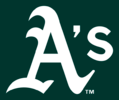
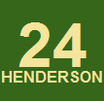
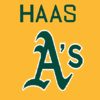

.jpg)



